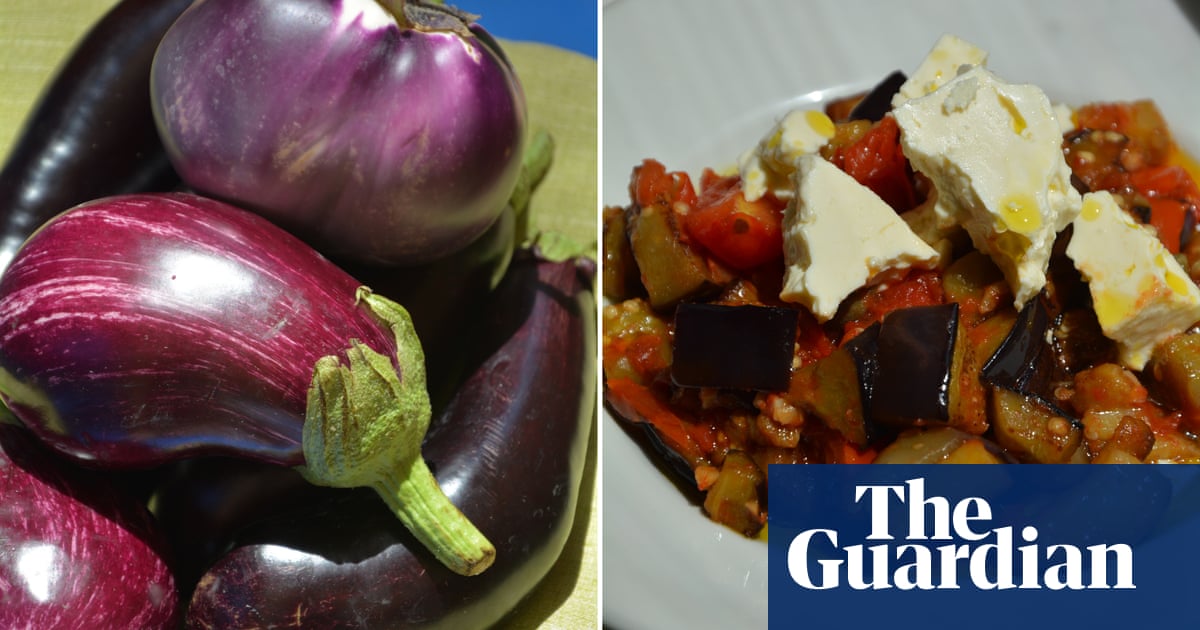
Even though, in these everything-always times, they never actually went away, it is not unreasonable to say that aubergines are back for the summer. Front row, heaped high, two euros a kilo: thank you very much.
Melanzana nera, the black beauty: some round, others like big tears with elfin hats. Melanzana violetta lunga: as slim as a carrot, as long as a cucumber and inky purple-black. Melanzana tonda viola with its grapefruit proportions and the colour of amethyst. Melanzana zebrina viola: streaked white and violet, like the inside cover of a fancy book. What an enviably striking bunch; and members of the deadly nightshade family – no wonder some were distrustful when this exquisite vegetable, believed to have originated in India and been brought to Europe by the Arabs, was first cultivated in Sicily and Spain. For some, that distrust and diffidence persisted for centuries. Pianta volgare (“vulgar plant”) was how the naturalist Pietro Andrea Mattioli referred to aubergine in 1568, on observing its frequent use by the volgo, or common people, who ate it “fried in oil, with salt and pepper, like mushrooms”.
Aubergines are the ants of the vegetable world, their ability much greater than their size. Rather than lifting, though, the aubergine absorbs – up to four times its own weight in liquid – soaking and sopping up whatever it is (oil, sauce, stock, like a sponge. Until it becomes the camel, when heat and salt breaks it. This reverses the process and it expels its own liquid, which evaporates, intensifying flavour and turning the aubergine from a foam mattress to a fat and silky one.
It is the ant and the camel aspects of aubergine that we want to harness in this recipe for aubergines cooked al funghetto. It’s a Neapolitan recipe, the name of which refers to the diced aubergine both looking and being cooked like mushrooms. Cubes of aubergine absorb olive oil with a deep or shallow fry, but then the heat, salt and stirring help to expel the liquid. Like a pushy parent, the cook then adds more liquid in the form of tomato juices, and the aubergine releases more combined juices back into a sauce, which thickens and clings. It is a claustrophobic circle that one friend refers to as “a pass the parcel of flavours”.
This circle is a reminder that, in cooking vegetables, so much depends on how we manage the water content of the veg in question. Talking of water, you don’t need to do a preliminary salt for this recipe, unless they are bitter (taste and see), in which case an hour sprinkled with coarse salt is worthwhile.
The aubergine skin seems even blacker after cooking and glints like squares of tourmaline, with its fringe of oil, in the red slump of tomatoes. We eat melanzane al funghetto with lumps of salted ricotta or feta, pan-melted cheese such as scamorza, provola or halloumi, or with boiled potatoes. It is also a dish unto itself, needing only bread in order that the thick, oily juices, which have already been soaked up and released, can be soaked up once more, by us. After all, we are all sponges.
Aubergine with tomatoes - melanzane al funghetto
Serves 4
1-1.2 kg aubergines
Olive oil
2 garlic cloves
400g cherry tomatoes, quartered
Salt
1 tbsp capers
1 small handful basil
Cut the aubergines into 1.5cm dice and squeeze them dry with kitchen towel.
In a large, deep frying pan set over a medium flame, warm six tablespoons of olive oil until hot, then add the aubergine cubes and fry, moving them constantly with a wooden spoon, until soft and golden. Tip on to a plate.
Heat two tablespoons of olive oil in the same pan, add the garlic – crushed for a milder flavour, sliced for a stronger one, chopped for the strongest – and fry until fragrant, being careful not to let it burn. Add the tomatoes and a pinch of salt, then cook over a lively heat for five minutes.
Add the capers, then stir in the aubergine and cook for another 10 minutes, adding the basil in the last minutes of cooking.
The Link LonkAugust 03, 2020 at 05:00PM
https://ift.tt/317Cqac
Rachel Roddy's recipe for aubergine with tomatoes - The Guardian
https://ift.tt/2VAxJ6V
Tomato

No comments:
Post a Comment